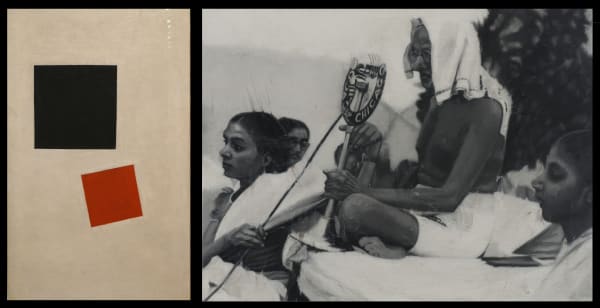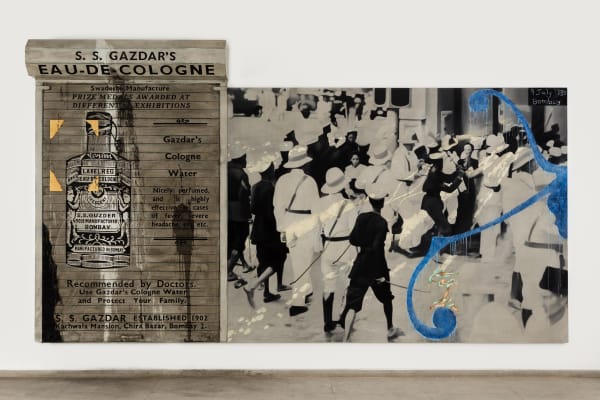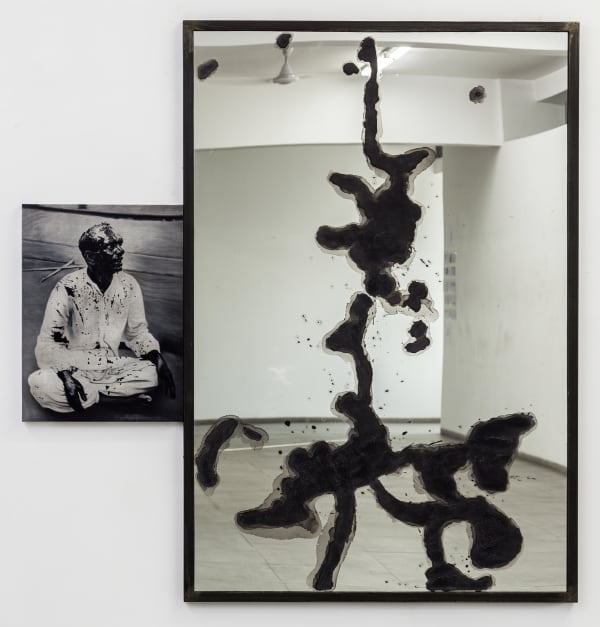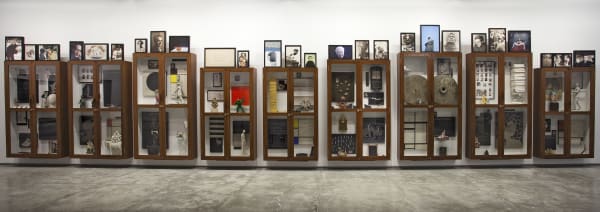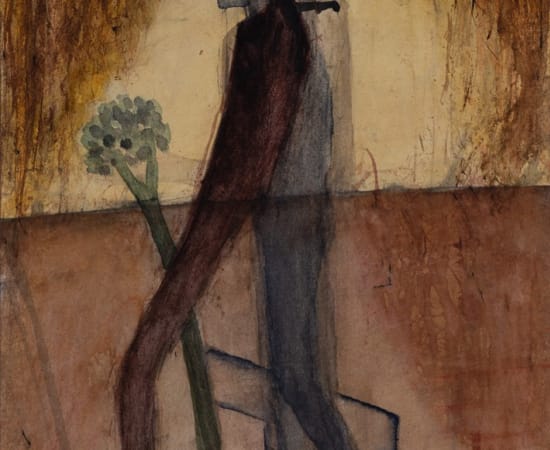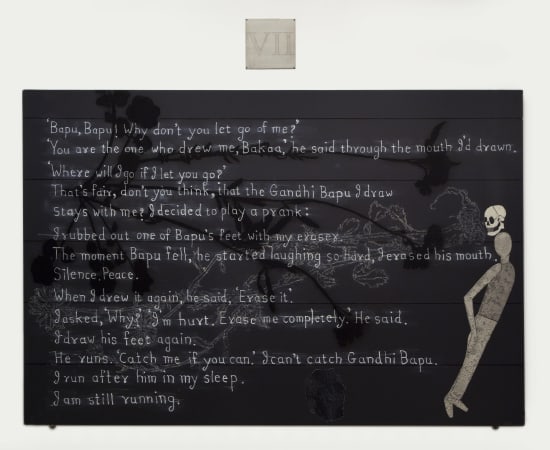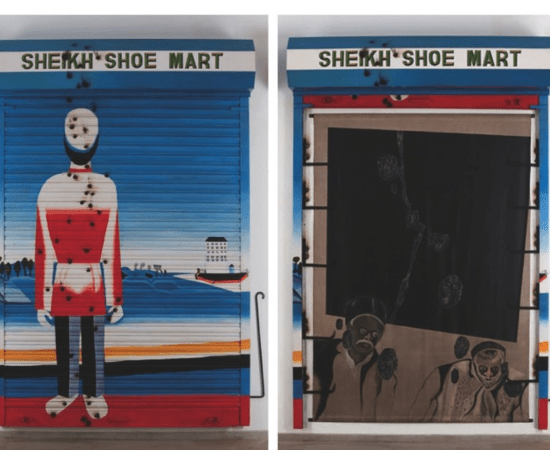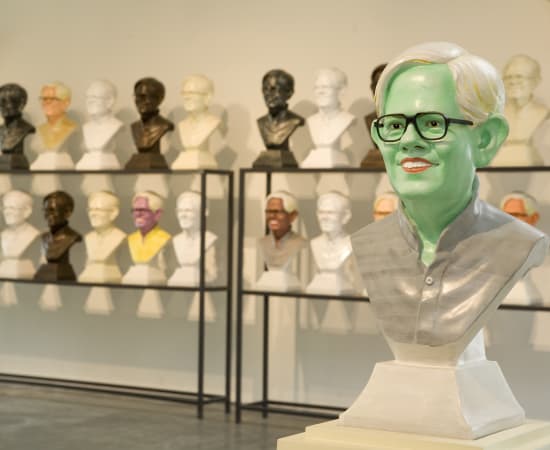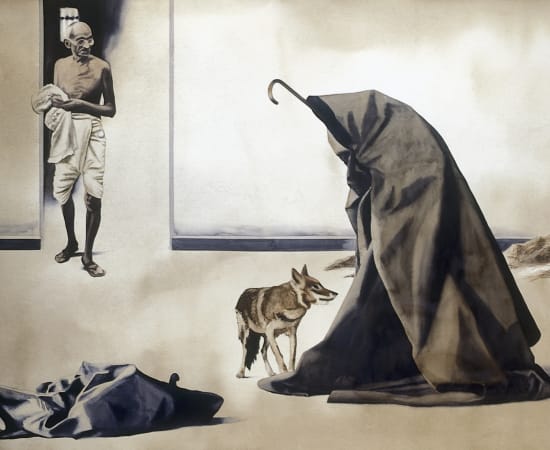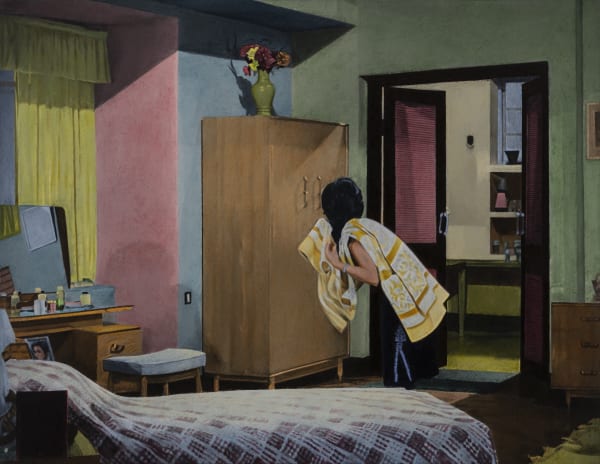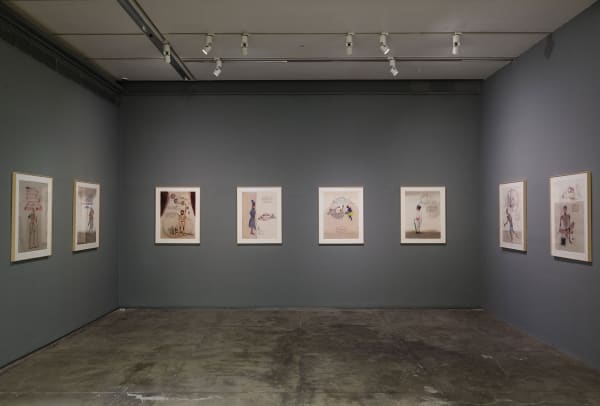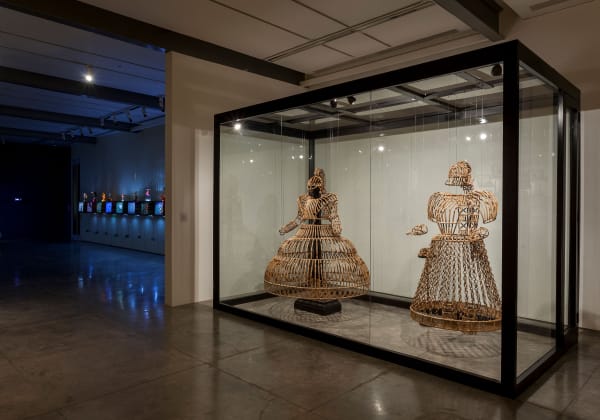Atul Dodiya Indian, b. 1959
-
 Devotees, 2022
Devotees, 2022 -
 Man abandoning himself , 2022
Man abandoning himself , 2022 -
 Mahatma on his last birthday, 1947, 2018
Mahatma on his last birthday, 1947, 2018 -
 'Untitled', 2018
'Untitled', 2018 -
 'Police Crackdown, Bombay, July 9, 1930’, 2015
'Police Crackdown, Bombay, July 9, 1930’, 2015 -
 Untitled , 2014
Untitled , 2014 -
 Untitled, 2014
Untitled, 2014 -
 Bako exists. Imagine, 2011
Bako exists. Imagine, 2011 -
 Meditation (with open eyes), 2011
Meditation (with open eyes), 2011 -
 Sheikh Shoe Mart, 2010
Sheikh Shoe Mart, 2010 -
 Shri Khakhar Prasanna, 2005
Shri Khakhar Prasanna, 2005 -
 Bapu at Rene block Gallery, New York-1974, 1998
Bapu at Rene block Gallery, New York-1974, 1998
b. 1959, in Mumbai, India
Atul Dodiya is one of India’s most distinguished artists. His works narrate as much about the history of art and the socio-political climate of India, as they are encoded in autobiography. Dodiya grew up in a middle-class Gujarati home in Ghatkopar, Mumbai. He trained at the Sir JJ School of Art and received acclaim early in his career for his paintings inspired by figurative artists such as Bhupen Khakhar, Sudhir Patwardhan, and Gieve Patel. He strengthened his unique vocabulary informed by French and Gujarati literature, Euro-American masters and modernists, global cinema, and popular culture while studying at the École des Beaux-Arts (1991-2).
Dodiya’s painting, The Bombay Buccaneer (1994) marked his departure from photorealism. He produced a satirical interpretation of a poster of the Bollywood film, Baazigar, replacing the image of the actor with a self-portrait of himself posing in a manner of James Bond. In his glasses, Dodiya depicted an image of Bhupen Khakhar in one eye and David Hockney in the other. These references to cinema, artistic predecessors, and the city of Mumbai continue to feature in his practice. In 2001, Dodiya participated in the exhibition, Century City curated by Geeta Kapur and Ashish Rajadhyakshaat the Tate Modern, for which he created the first of his iconic paintings on roller-shutters. He referred to these shutters in response to the curfews during the Bombay riots in the 1990s, when they shielded shops at moments of unrest. Continuing to collage referents ranging from newspaper clippings depicting political imagery to works by Mondrian, Duchamp, and Jasper Johns, to Raja Ravi Varma’s oleograph, his shutter-works such as his Missing series (late 1990s), Dead Ancestors (2012), and Police Crackdown, Bombay, July, 1930 (2015), among others offer takes on political events, personal circumstances, and propagandistic tools.
In response to the violence and rise in fundamentalism during the Bombay riots, Dodiya also turned to the figure of Gandhi, emblematic of peace and secular values, in works such as Lamentation (1997) and Bapu at Rene Block Gallery, New York-1974 (1998). In these paintings, Dodiya exemplifies his ability to fuse history and autobiography, the memory of the self and that of the nation. In his 1999 series, An Artist of Non-Violence, Dodiya narrates Gandhi’s life by portraying mundane details including receipts and pages from his diary. In his 2011 exhibition, Bako Exists, he staged an imaginary friendship between Gandhi and Bako, a young protagonist featured in the Gujarati poet Labhshanker Thaker’s writing. Gujarati poetry has been a strong influence in Dodiya’s work appearing prominently in his Antler Anthology series (2004), exhibited at Documenta 12.
One of Dodiya’s seminal installations, Broken Branches (2003) that was exhibited at the Venice Biennale 2019, is inspired by his visit to Gandhi’s Porbandar home that displays his letters and photographs in wooden cabinets. In his installation, Dodiya replicated these cabinets, assembling in them - prosthetic limbs, construction tools, and found objects to assert his rejection of intolerance and hate. Since 2003, Dodiya has continued to create cabinet-based installations such as Meditation (with open eyes) (2011), and Fragrance of a paper rose (2018) that are reminiscent of colonial Cabinets of curiosities, carrying forward the archival instinct that his paintings exhibit. These feature details from previous works, art historical texts, and other artefacts. In his photo installation, Celebration in the Laboratory at the Kochi-Muziris Biennale 2012, Dodiya celebrated the figures who have contributed to the development of cultural infrastructure in India. His 2014 exhibition, 7000 Museums: A Project For The Republic Of India at the Dr. Bhau Daji Lad Museum in Mumbai, featured his cabinet-installations that were displayed alongside tongue-in-cheek watercolour paintings that proposed museums in cities and towns like Ranchi, Alwar, and Jumritalaiya to raise broader questions surrounding museology.
According to cultural theorist Ranjit Hoskote, Dodiya’s “seeming flamboyant maximalism is held in productive counterpoint by his awareness of how fragile the production of culture and the records of history are.” This sensitivity is prominent in his 2017 exhibition, Girlfriends: French, German, Italian, Egyptian, Santiniketan, Ghatkopar… where he returned to figurative painting, revisiting female portraits by masters from a wide range of times and places to generate strong emotions.
The citational qualities of Dodiya’s art, coupled with his extensive exploration of his place within Indian and global contexts reveal that while he identifies distinctly as a citizen of Mumbai, his artistic roots stem from the world at large.
The artist lives and works in Mumbai, India.
-

Radio Ceylon Paintings: Vol. I
Atul Dodiya 9 Jan - 22 Feb 2025Atul Dodiya’s ‘Radio Ceylon Paintings: Vol. I’ appears to be a nostalgic tribute, where he paints portraits of a galaxy of well-known (and many unknown maestros) of the Hindi film...Read more -

Part 1: Framing | CheMoulding: Framing Future Archives
Curated by Shaleen Wadhwana | 60 Years of Gallery Chemould 15 Sep - 22 Oct 2023Anant Joshi, Archana Hande, Atul Dodiya, Bhuvanesh Gowda, Desmond Lazaro, Dhruvi Acharya, Gigi Scaria, Jitish Kallat, Madhvi Subrahmanian, Meera Devidayal, Mithu Sen, NS Harsha, Ram Rahman, Ritesh Meshram, Shakuntala Kulkarni,...Read more -

Traces of Place
Group Show 13 Jul - 19 Aug 2023How does a place influence our emotions and behaviour? What are the various experiences that two people can have of the same place? And can a place be reimagined to...Read more -

Dr. Banerjee in Dr. Kulkarni's Nursing Home and Other Paintings 2020-2022
Atul Dodiya 12 Jan - 25 Feb 2023Drawing from popular Indian cinema, Atul Dodiya creates paintings populated by iconic characters in his signature realistic style. This is not the first time Dodiya has painted from cinema, and...Read more -

Modus Operandi III: Together Alone
Group Show 11 Aug - 10 Sep 2022The premise of Modus Operandi began and continues with an exhibition of Chemould's roster of artists - every iteration presents us an opportunity to exhibit them under one roof, in...Read more -

Conversations on Tomorrow
Sadie Coles HQ, London 11 May - 18 Jun 2022'What comes after reason?' Bonaventure Soh Bejeng Ndikung asked last year.1 By addressing a strain of 'reason' - a rational, canonizing, cerebral, and intoxicating form of thought prescribed by the...Read more -

On|Site | Entry Only
Group show 3 - 9 Mar 2021A collaborative project between four galleries at Bikaner House, New Delhi. Bikaner House, a former residence of the Maharaja of Bikaner in Rajasthan, retains its grand aura of a distinguished...Read more -

Photo / Concept
Group show | In-Touch Edition II 5 Jun - 5 Jul 2020Read more -

Out-site / Insight
Group Show | In touch Edition I 24 Apr - 23 Jul 2020We approached our artists inquiring how they were doing in this time of isolation. Several of them are unable to make art - using their time to read, watch films,...Read more -

Modus Operandi II
Group Show 18 Jul - 24 Aug 2019Synonymous with the first edition of Modus Operandi, where we brought together over 25 Chemould artists and their unique artistic language in dialogue with each other through various mediums, we...Read more -

Seven Minutes of Blackmail
Atul Dodiya 17 Jan - 21 Feb 2019This set of paintings explores Dodiya’s obsession with the medium of film, where his signature photographic painting style is often mistaken for photography. In this exhibition, he pays homage to...Read more -

Modus Operandi
Group Show 13 Jul - 18 Aug 2018This July, Chemould Prescott Road presents Modus Operandi, a show that has been devised by Shireen Gandhy and the Chemould team, brin ging together a large number of Chemould artists...Read more -

A Summer Mix
Group Show 20 May - 15 Jul 2015Aditi Singh | Anju Dodiya | Atul Dodiya | Bhuvanesh Gowda | Desmond Lazaro | Dhruvi Acharya | Gigi Scaria | Jitish Kallat | Lavanya Mani | Meera Devidayal |...Read more -

Aesthetic Bind: Cabinet Closet Wunderkammer
50 Years of Chemould | Group Show 20 Jan - 3 Mar 2014There are small exhibitions within this exhibition compacted by a set of framing devices. The Closet holds intimate things: clothes, mementos, secrets about self and identity, fears or even crimes....Read more -

Bako Exists. Imagine
Atul Dodiya 10 - 20 Oct 2011Bako exists. Imagine is a text-based work which consists of twelve paintings and an installation with nine wooden cabinets. These poetic episodes are based on a fiction, written in Gujarati...Read more -

Shri Khakhar Prasanna
Atul Dodiya 2 Feb - 3 Mar 2007When the idea of a new gallery and an expansion programme emerged, it was very clear to Shireen that she would open the gallery with an Atul Dodiya show. Dodiya’s...Read more -

crossing generations: diVERGE
40 Years of Chemould | Group Show 2 - 14 Dec 2003diVERGE is premised on the polyphony articulated by contemporary artists in India. Rather than zooming in to chart a convergent discourse, the exhibition pans over a diverse spectrum of subjectivities...Read more
-
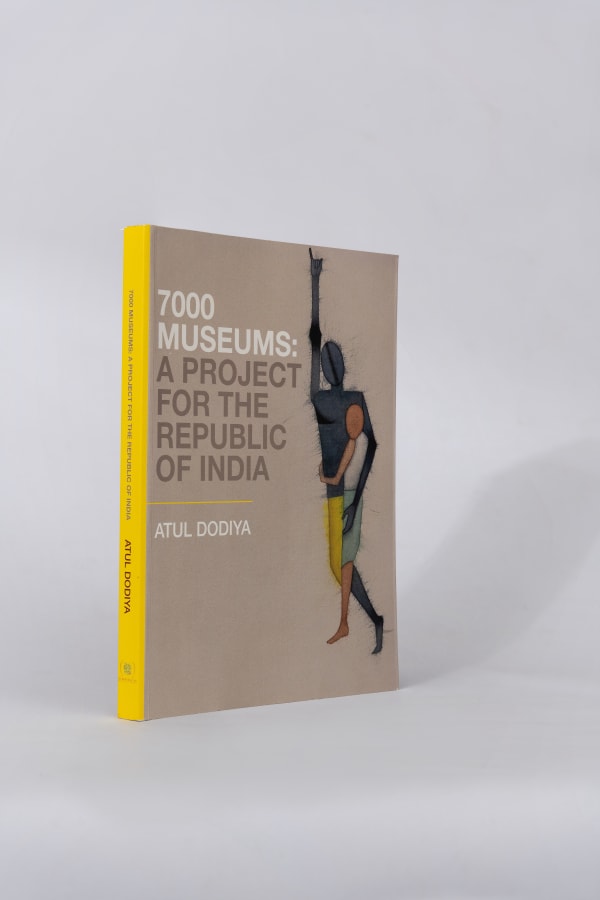
7000 Museums: A Project for the Republic of India
Atul Dodiya 2016Softcover, 211 pagesRead more
Dimensions: 30.5 x 28cm -
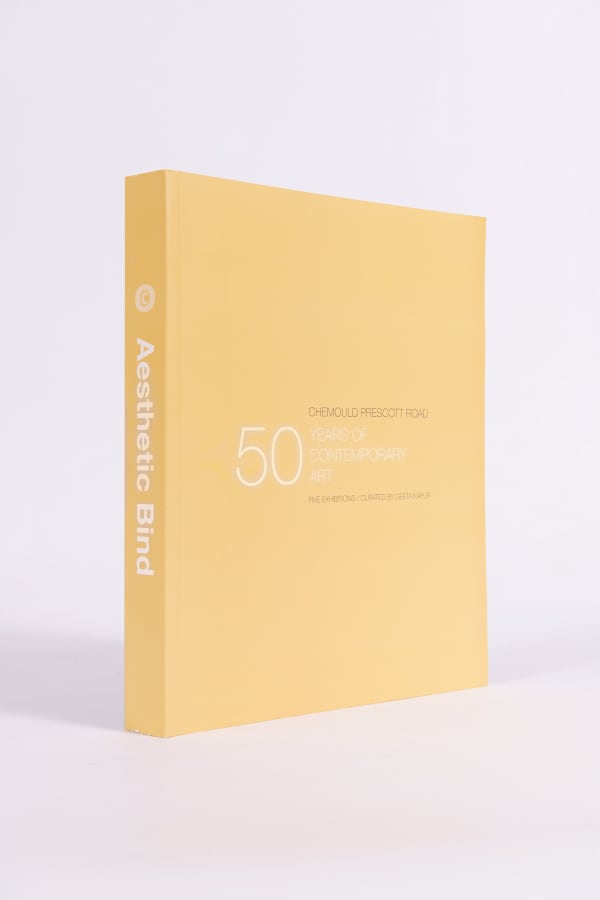
Aesthetic Bind
50 Years of Contemporary Art 2013 - 14SoftcoverRead more
Dimensions: 24 x 29 cm -
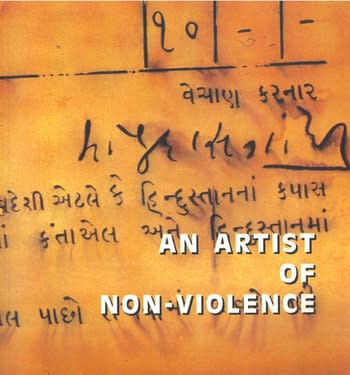
Artist of Non-violence
Atul Dodiya 1999 Read more -

Atul Dodiya & Bhupen Khakhar
Atul Dodiya & Bhupen Khakhar 2010Softcover, 26 pagesRead more
Dimensions: 25 x 18.25cm -
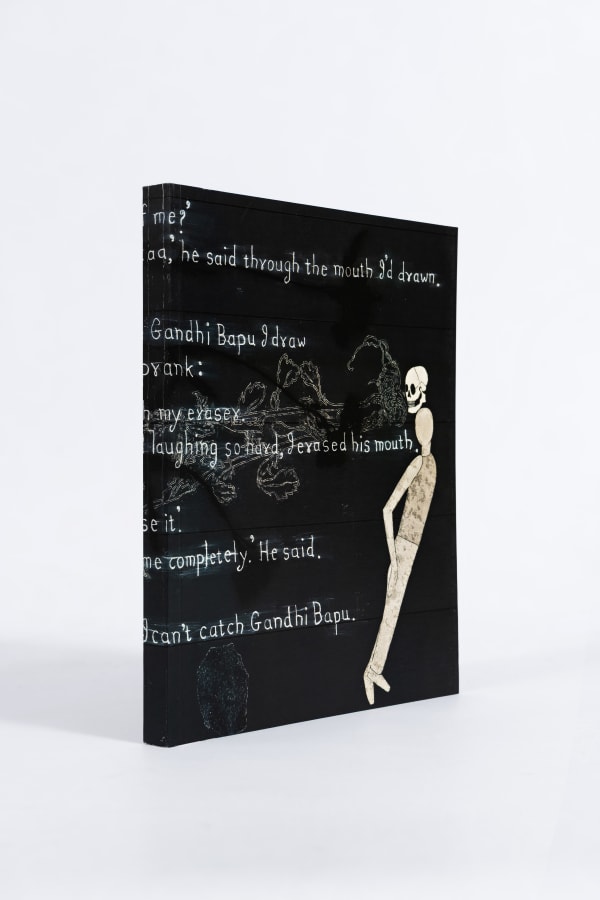
Bako Exists. Imagine
Atul Dodiya 2011SoftcoverRead more
ISBN: 978-81-908879-3-9
Dimensions: 28 x 21 cm -

Bhupen Among Friends
Bhupen Khakhar 2005Softcover, 53 pagesRead more
Dimensions: 28 x 28cm -
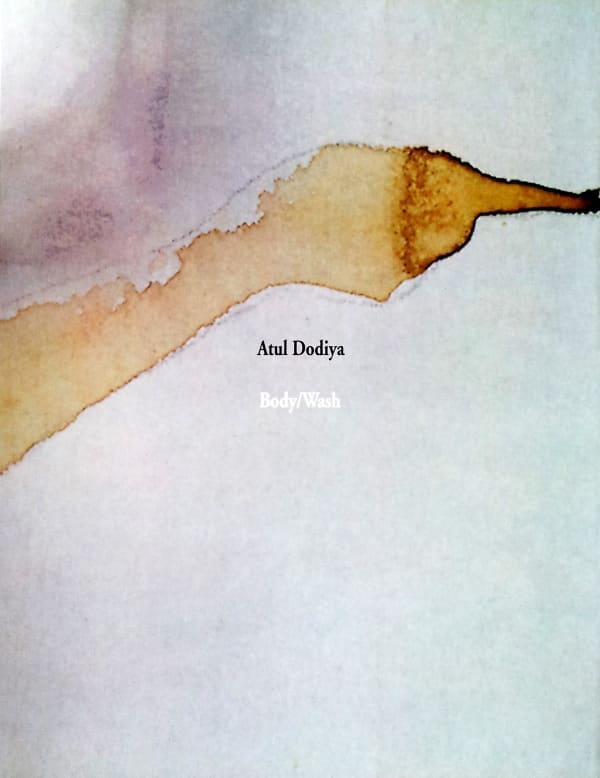
Body/Wash
Atul Dodiya 2006 Read more -

crossing generations: diVERGE
40 Years of Gallery Chemould 2003SoftcoverRead more
Dimensions: 29.5 x 23 cm -
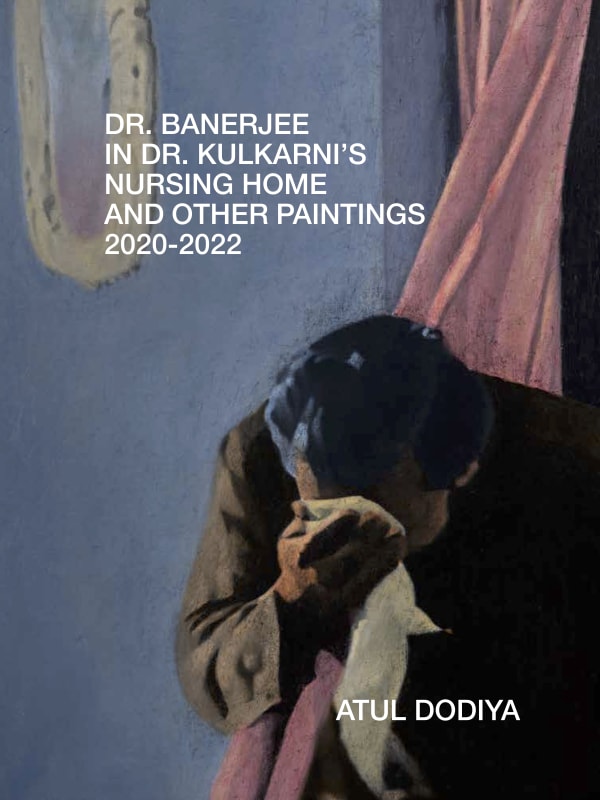
Dr. Banerjee in Dr. Kulkarni's Nursing Home and Other Paintings 2020-2022
Atul Dodiya Jyotindra Jain, 2023Hardback, 90 pagesRead more
Publisher: Silverpoint Press
ISBN: 978-81-954610-3-5
Dimensions: 11 x 8 x 2 inches -
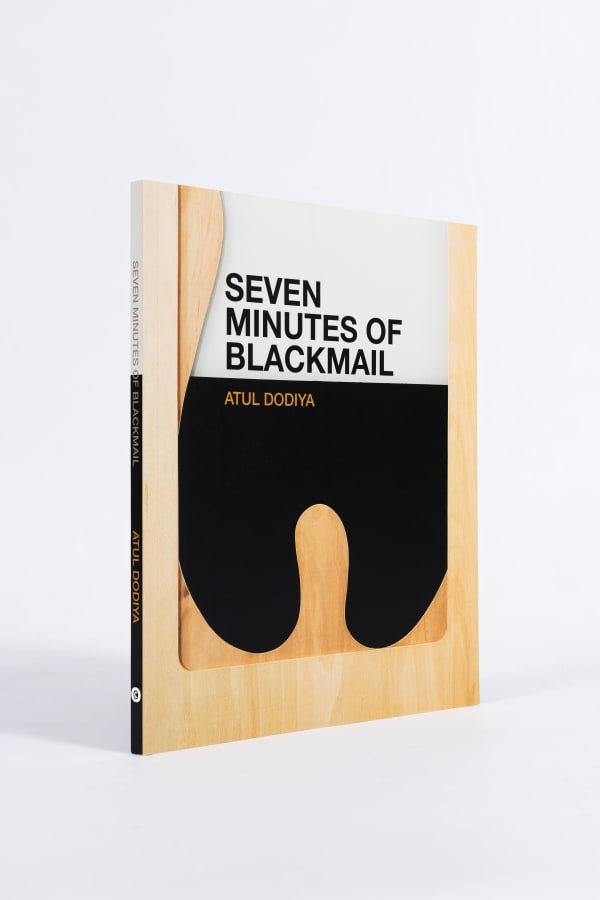
Seven Minutes of Blackmail
Atul Dodiya 2019Softcover with flapsRead more
ISBN: 978-81-943497-0-9
Dimensions: 30 x 23 cm -
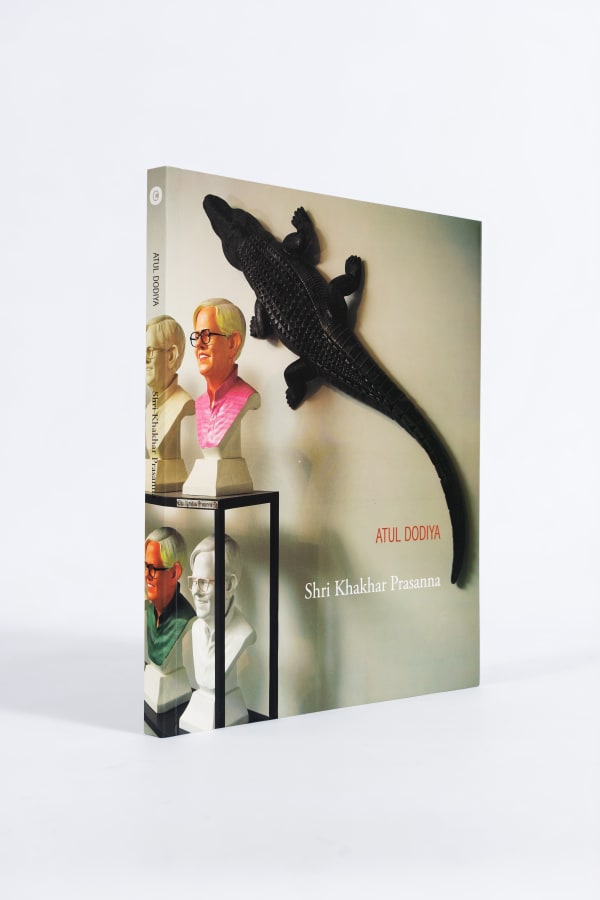
Shri Khakhar Prasanna
Atul Dodiya 2008SoftcoverRead more
ISBN: 0-944142-36-2
Dimensions: 29 x 24 cm
-
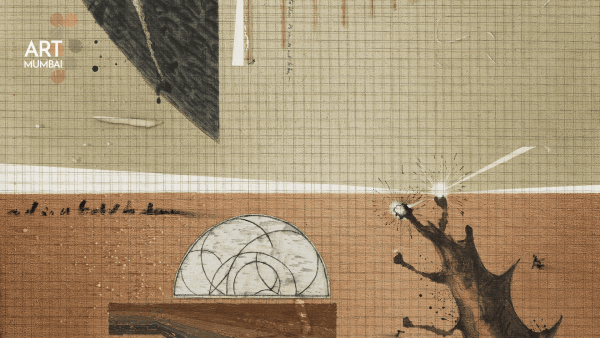
Art Mumbai 2024
Mumbai 14 - 17 Nov 2024Booth 28 Public days: NOV 16 - 17, 2024 We look forward to welcoming you once again in person to our booth at Art Mumbai...Read more -

India Art Fair 2024
New Delhi 1 - 4 Feb 2024Booth B2 Public days: Feb 1 - 4, 2024 We look forward to welcoming you once again in person to our booth at India Art...Read more -

Art Basel 2023
Basel, Switzerland 15 Jun - 18 Dec 2023Booth J9 We look forward to welcoming you once again in person to our booth at Art Basel 2023. Highlights will include works by Anju...Read more -
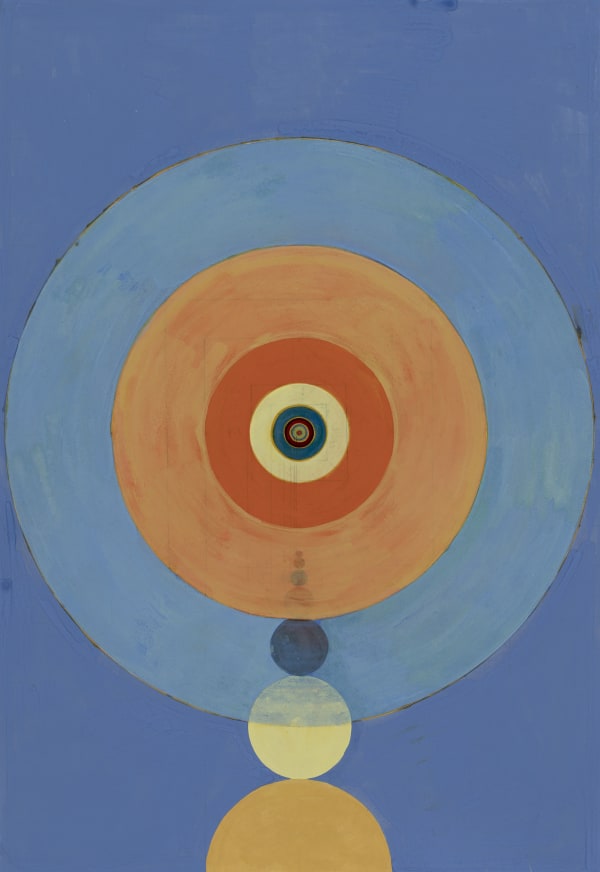
Art Dubai
Dubai 1 - 5 Mar 2023Booth E1 Public days: Mar 1 - 5, 2023 We look forward to welcoming you once again in person to our booth at Art Dubai...Read more -
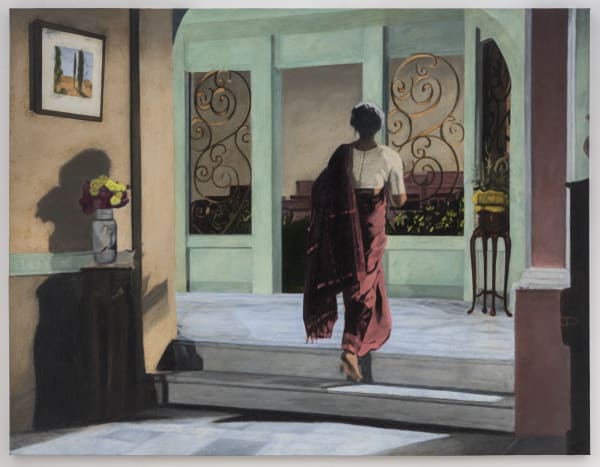
India Art Fair 2023
New Delhi 9 - 12 Feb 2023Booth B2 Public days: Feb 9 - 12, 2023 We look forward to welcoming you once again in person to our booth at India Art...Read more -
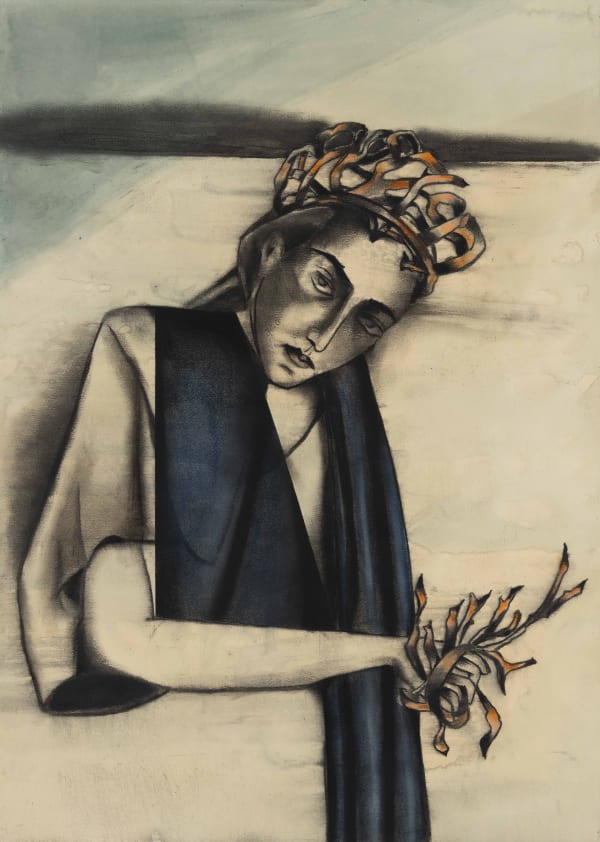
India Art Fair 2022
New Delhi 28 Apr - 1 May 2022This year we look forward to returning to India Art Fair; presenting new works across multiple mediums created by nine of the gallery artists. Anju...Read more -

Art Basel 2021
Basel, Switzerland 20 - 26 Sep 2021Public days: Sep 20 - 26, 2021 We look forward to welcoming you once again in person to our booth at Art Basel 2021. Highlights...Read more -

Art Basel Hong Kong 2020
Online 18 - 25 Mar 2020Online Viewing Room Public days: March 18 - 25, 2020 To access the Online Viewing Rooms, create an Art Basel Profile here Chemould Prescott...Read more -
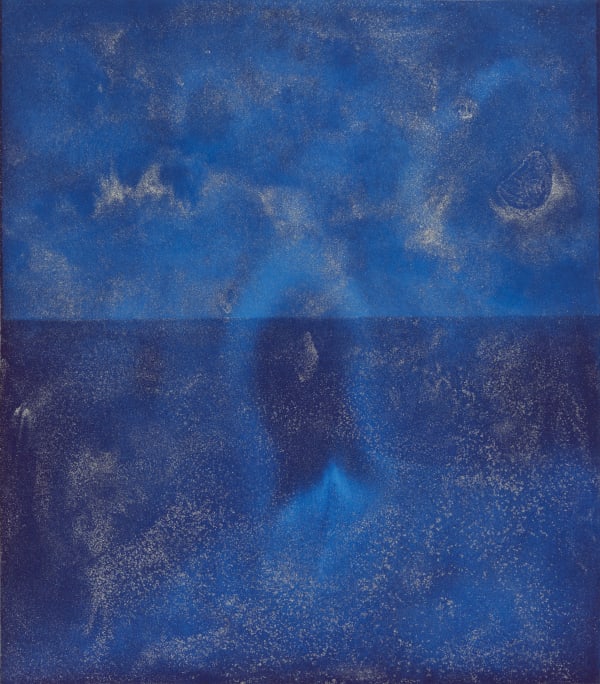
India Art Fair 2020
New Delhi 30 Jan - 2 Feb 2020Public days: Jan 30 - Feb 2, 2020 Chemould Prescott Road presents a suite of works this year at India Art Fair 2020 that reflect...Read more -
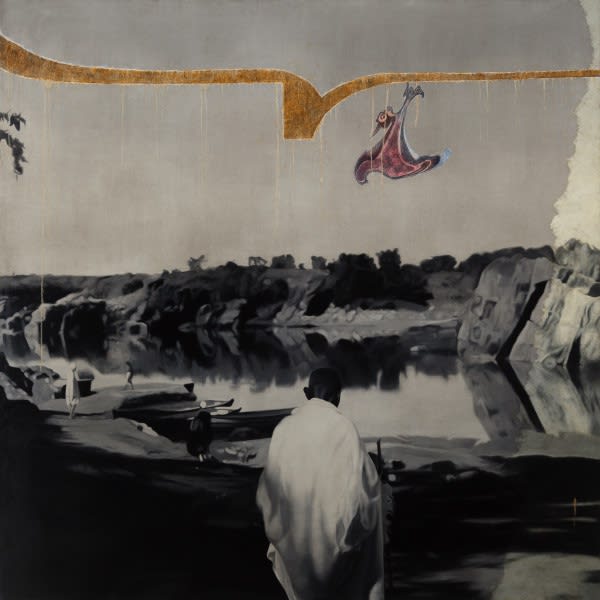
Art Basel 2019
Basel, Switzerland 12 - 16 Jun 2019Public days: June 12 - 16, 2019 Chemould Prescott Road has a roster of senior, mid-career and young artists who have been part of the...Read more -

India Art Fair 2019
New Delhi 31 Jan - 3 Feb 2019Public days: Jan 31 - Feb 3, 2019 Chemould Prescott Road presents a suite of works this year at India Art Fair 2019 that reflect...Read more -

Art Basel 2018
Basel, Switzerland 13 - 17 Jun 2018Chemould Prescott Road presents a suite of works this year at Art Basel that reflect the diverse sensibilities of its gallery programme. From Anju Dodiya...Read more -
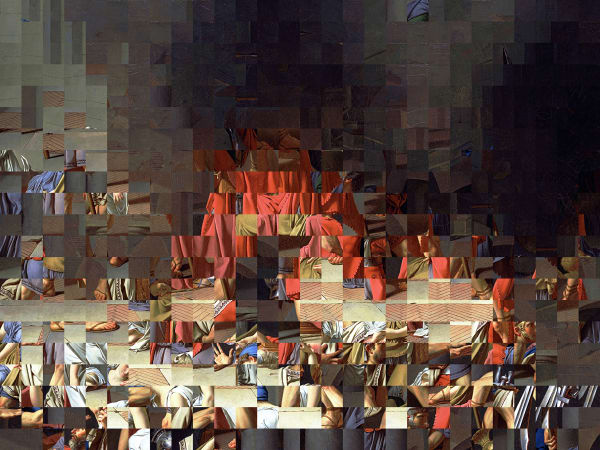
Art Basel 2017
Basel, Switzerland 15 - 18 Jun 2017Public days: June 15 - 18, 2017 Chemould Prescott Road has a roster of senior, mid-career and young artists who have been part of the...Read more -
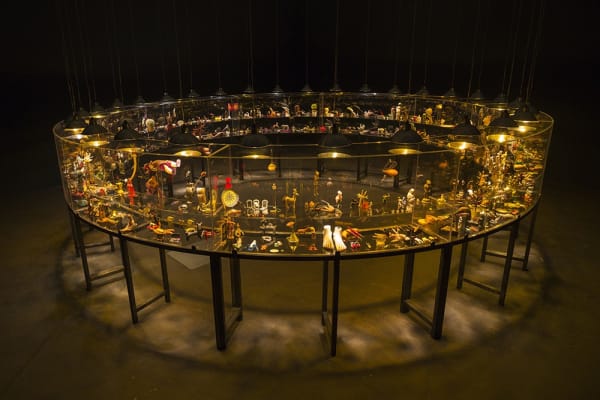
Art Basel 2016 Unlimited
Basel, Switzerland 16 - 19 Jun 2016Public days: June 16 - 19, 2016 Chemould Prescott Road has a roster of senior, mid-career and young artists who have been part of the...Read more -
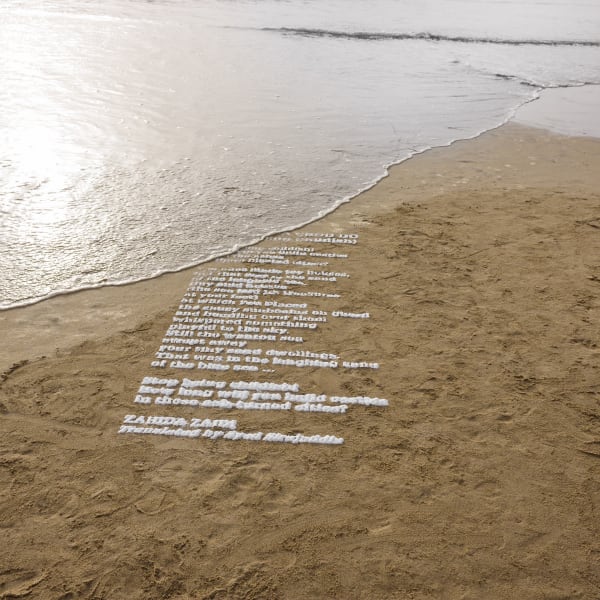
Art Basel 2015
Basel, Switzerland 18 - 21 Jun 2015Public days: June 18 - 21, 2015 Chemould Prescott Road has a roster of senior, mid-career and young artists who have been part of the...Read more -

Art Basel Hong Kong 2015
Hong Kong 15 - 17 Mar 2015Public days: March 15 - 17, 2015 Chemould Prescott Road has a roster of senior, mid-career and young artists who have been part of the...Read more -

Art Basel 2014
Basel, Switerzland 19 - 22 Jun 2014Public days: June 19 - 22, 2014 Chemould Prescott Road has a roster of senior, mid-career and young artists who have been part of the...Read more -
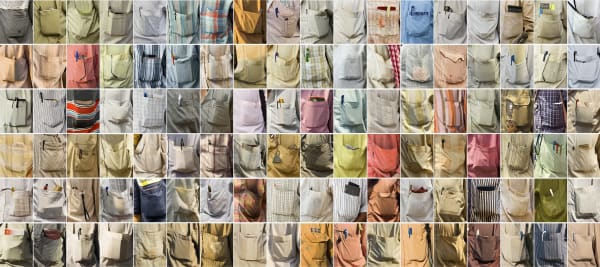
Art Basel Miami 2010
Miami Beach 2 - 5 Dec 2010Public days: Dec 2 - 5, 2010 Chemould Prescott Road has a roster of senior, mid-career and young artists who have been part of the...Read more -
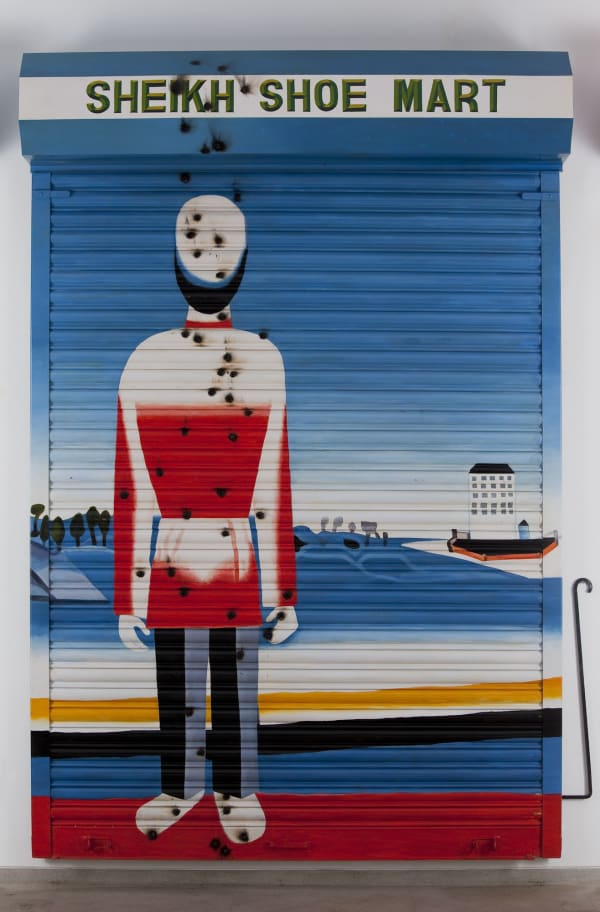
Art Basel 2010
Basel, Switzerland 16 - 20 Jun 2010Public Days: Jun 16 - 20, 2010 Chemould Prescott Road participates with a curated booth in Art 41 Basel of two artists from two generations:...Read more


